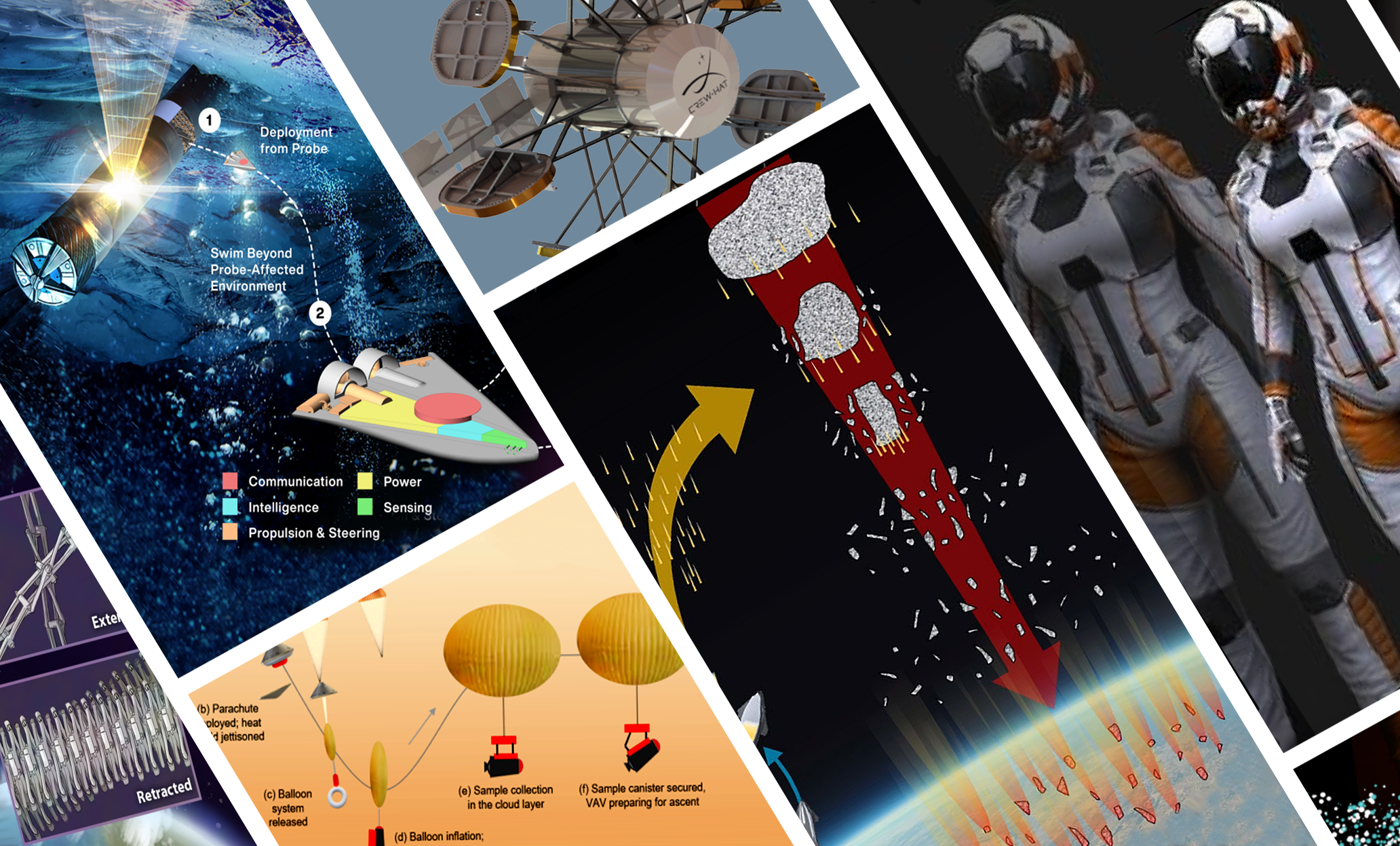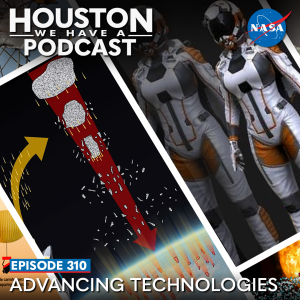
From Earth orbit to the Moon and Mars, explore the world of human spaceflight with NASA each week on the official podcast of the Johnson Space Center in Houston, Texas. Listen to in-depth conversations with the astronauts, scientists and engineers who make it possible.
On episode 310, NASA Innovative Advanced Concepts leaders Mike LaPointe and John Nelson discuss unique and interesting solutions to complex spaceflight challenges. This episode was recorded on September 21, 2023.

Transcript
Host (Gary Jordan): Houston, we have a podcast! Welcome to the official podcast of the NASA Johnson Space Center, Episode 310, “Advancing Technologies.” I’m Gary Jordan, I’ll be your host today. On this podcast, we bring in the experts, scientists, engineers, and astronauts, all to let you know what’s going on in the world of human spaceflight and more. On this podcast, we’ve discussed plans to advance humanity’s future on the Moon and Mars and described many of the technologies and engineering solutions that will make this future possible. A lot of thought has been put into these missions given our knowledge and understanding of the capabilities of today, and of course, understanding that technologies will grow and mature. Now, what about far out ideas that are in their infancy, but may be worth trying out? Well, NASA has a home for these two. There’s a program at NASA called NASA Innovative Advanced Concepts that welcomes these far-out ideas and provides inventors a way to mature them with the hopes that maybe just maybe they could help us explore the cosmos and improve our lives on Earth.
Recently, this organization happened to host a symposium here in Houston, right across the street from the Johnson Space Center. And for several days, inventors, scientists, and technologists got together to discuss some of the fantastic, and I’ll admit, unbelievable things that are in work. Almost like a science fiction convention, but for people trying to make science fiction into science fact. While they were in town, I was able to grab Mike LaPointe and John Nelson, program executive and deputy program executive for NIAC respectively for a few moments to share their perspective on why these initiatives are so important, and to get us pumped about some of the cool technologies being discussed. I, of course, zeroed in on human spaceflight technologies like nuclear thermal propulsion that can take humans to and from Mars faster than ever, or a lunar oxygen pipe that gives us a sense of long-term infrastructure on the Moon to support human missions. But it’s hard not to be inspired by technologies like noise-free air taxis, or technologies that can protect all of humanity from a planet-threatening asteroid. Lots to discuss in so little time. Let’s get right into our conversation with Mike LaPointe and John Nelson. Enjoy.
[Music]
Host: Mike and John, thank you so much for coming on Houston We Have a Podcast. It’s great to have both of you.
Mike LaPointe: Thank you. It’s great to be here.
John Nelson: Thank you. It’s fantastic to be here.
Host: Alright. Yeah, you’re coming on the back end of a symposium here just right across the street. So it’s just been probably a whirlwind of a day for you both, just hearing incredible ideas. Michael, start with you. What was that like, the symposium?
Mike LaPointe: Oh, it’s great. We do this once a year at the end of September, bringing all the NIAC fellows together that are currently funded. So phase one, two, and three. So we have a good selection of projects that have just started out and projects that are just winding up through their third phase. And so it’s just a lot of energy in the room. It’s great to hear all the different ideas, all the collaborations going on in the background. It’s just a very energetic, very fun three-day event.
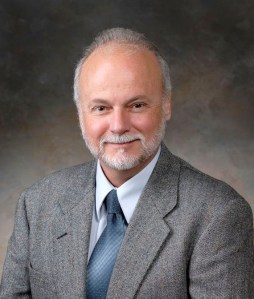
Host: Wow. Alright. So we’re going to capitalize off of that energy. That’s great. And we’re going to go into what those phases mean. We’re going to go into a little bit more about NIAC. John, same experience?
John Nelson: Oh, yeah. It was a fantastic week, and as Mike said, we do this every year. We like to do it in different locations, so I believe this is the first time we’ve done it near JSC and that was a great experience. We had some fantastic keynote speakers and it was just great discussions.
Host: Good experience. You think you’d come back to Houston?
John Nelson: Oh, absolutely.
Host: I put you on the spot a little bit.
Mike LaPointe: You guys don’t realize it’s supposed to be fall, right?
[Laughs]
Host: Fall? That’s a thing? We’ve only heard rumors.
Mike LaPointe: That was on Sunday, right?
[Laughs]
Host: That’s true. That’s true. It’s still going to be hot here, but no, I’m glad you guys came down and really, it’s a perfect opportune moment to get a chance to meet both of you and talk more about NIAC. Wanted to start by just kind of understanding how you got to where you are. Michael, let’s start with you. You’re now the program executive Ss what’s your background? How’d you get to be the program executive of this wonderful program?
Mike LaPointe: Oh, thank you. And it is a wonderful program. I’m very lucky to be here. So I started out as a contractor at Glenn doing electric propulsion work. I had the opportunity to go down to Marshall as a civil servant in 2004 as part of the JIMO project, the Jupiter Icy Moon Orbiter. They were doing nuclear propulsion at the time and so I joined the Nuclear Systems Office there. JIMO of course got canceled, and so we went to different organizations, became a branch chief, and became a deputy division manager. Jason Derleth, who was running NIAC at the time back in 2018, asked if I’d like to join as a program manager. So I worked with Jason for a couple years as the NIAC PM, which was great, went on to do a program executive for internal NASA programs, CIF, Center Innovation Fund and Early Career Initiative. And then Jason unfortunately took a job with Goddard, unfortunately for us, good for him. So they asked me to take over NIAC as well.
Host: Wonderful. And so now you are the program executive.
Mike LaPointe: I am.
Host: Very good. Alright, and you said thermonuclear propulsion, right? And I think that was one of the things that was talked about during the symposium.
Mike LaPointe: So JIMO was nuclear propulsion at the time, but we actually have had concepts with thermonuclear nuclear propulsion fusion. It’s been awesome.
Host: It’s a very cool technology. I can’t wait to explore it a little bit. John, a little bit of how you became deputy.
John Nelson: Sure. Not a rocket scientist, but I have spent most of my career as a contractor in NASA Headquarters. Started off supporting scientific and technical peer review, primarily in life sciences. My background is in biomedical engineering by education. And I became part of the New Space Technology Mission Directorate about 11 years ago. For years, I led a support contract supporting several different programs within STMD looking at strategy and execution and improvement of programs. I was lucky enough around 2017 or so to start supporting NIAC as a contracted advisor. Love the program, just absolutely fell in love with it and couldn’t get enough. So when the opportunity came to pursue a position solely focused on NIAC and a few other Innovative programs within our portfolio, I jumped at it. So it’s been about a year now that I’ve been Mike’s deputy, and it’s the best job I’ve ever had.

Host: Alright. Well, wonderful to have you. Yeah. This is great. Now we’ll be diving into NIAC and a little bit more about it, but John, you mentioned STMD, the Science Technology Mission Directorate. We haven’t had a lot of guests from this mission directorate. If you had to kind of give our audience an overview of what that is, what this science technology mission directorate focuses on at NASA, how exactly would you characterize that?
John Nelson: So, space technology is a little different than other mission directorates. We’re not mission-focused in that we’re not focused on specific space missions, either robotic or human. We’re looking at cross-cutting, promising technologies that could apply to multiple missions for NASA, but also for commercialization for commercial space and working with other government agencies. So it truly is a dedicated technology organization within NASA. Not that there isn’t technology development within the other mission directorates, but that is the purpose of our mission directorate. To serve as a standalone, technology organization.
Host: Is it maybe so that you can have a more broader approach in the sense that some mission directorates are focused on the mission, so it’s like, “okay, what are the technologies we need to accomplish the mission?” Whereas you are focused mainly on observing and thinking about technologies and say, “okay, how far and wide can we take this? How many programs can it support? How can it benefit humanity?” You’re taking the holistic approach to technology.
John Nelson: Yes, absolutely. And what that means is we help fill the gap of technologies needed for plan missions, whether robotic or human. And it also allows us to look beyond the currently planned missions and to look even beyond the current decals at technologies that will be needed to enable future missions. And like I said, we’re also focused not only on NASA’s mission, but as commercial space and commercialization opportunities as well.
Host: Okay. Now, NIAC fits in this mission directorate, right?
John Nelson: Absolutely.
Host: Okay. So then what’s NIAC’s purpose? What’s NIACs goals? Michael, we’ll turn to you. How does that fit in the goals and objectives of the space technology?
Mike LaPointe: That’s a great question. So STMD, we have three main divisions, departments within STMD. One is Early-Stage Innovations and Partnerships, which is led by Jenn Gustectic, and that’s where NIAC falls, so does all the really early TRL activities. So we have prizes and challenges, you know, NIAC CIF, Center Innovation Fund Early Career Initiative. She also has the SBIR program under her wing. And then there’s the middle TRL range, which is tech maturation. That is where the game changing, development program resides. And then beyond that is tech demo missions. Which is more the higher TRL, let’s fly it and see how it works. And then it transitions into missions from there. So in STMD, we kind of cover the gamut of low TRL to high TRL. And then within that low TRL is where NIAC kind of sits.
Host: Okay. That’s it. It’s an organization based on maturity, and you have programs based on maturity. Wonderful. And so we’re going to be talking about NIAC. That’s the early concepts, right? Which is very fun cause you get some really cool, wild ideas. This is great. So this is how I sort of think of it, right? I’m not in the program, but when I look at it, I say, “alright, here, what kind of wild ideas can we take on and just see what we can do with it?” And hopefully, I’m not mischaracterizing it.
Mike LaPointe: That’s perfect. We toe the line of science fiction. It’s a perfect description.
Host: That’s great. Okay. So then, now you can think about it from, you know from a perspective of, “yeah, kind of bring it on.” But there has to be some organization to it, right? You don’t just have a phone line for anyone with a crazy idea, right? So, exactly how does it work for someone with a concept, an early concept, an idea, how do they get through the door?
Mike LaPointe: It’s a great question, too. So we do put out solicitations. So every year we put out a phase one solicitation in the June timeframe. It’s a two-step process. So we have Step A, which is a very short white paper-type submission where they present their concepts to us in a mission context. And the reason we ask for a mission context is just cause we do get ideas across the spectrum. We very open solicitation. We don’t say, “we need you to propose on propulsion.” They can propose anything that would help us enable or enhance a NASA mission. So it is entirely wide open. It’s open anyone in the U.S., any organization in the U.S., academia industry, inventors, government. So it’s a very broad spectrum of ideas that come in from a very broad spectrum of technology innovators.
And so what they can do is on the NIAC website there is a “how to apply to NIAC.” But basically, the solicitation comes out and gives very specific guidelines about what we’re looking for in terms of a proposal, but not in terms of an idea, other than propose an admission concept so we can compare this science instrument to this propulsion concept to this X, Y, Z, so we have some idea of the benefit to NASA, or other mission, agencies, other missions and concepts.
So the idea there is that once they propose to us, we have a screening process. Typically, we get about 300 Step A white papers per year in response to the solicitation. It’s a lot to go through. We go through it in the program office and we look for those specific things—so the solicitation calls out what we aren’t looking for within NIAC, which are like incremental steps, you know, things like that. So there’s a whole list of things we’re not looking for. We don’t really tell them what we are looking for. But once we get through the Step A process, basically we send out an invitation for Step B, which is a full-blown proposal to NIAC. And then out of that, we typically get about a hundred. And out of those we fund 12 to 16. Very competitive.
Host: Do you get to go out and sort of explore all these proposals that come in? Do you get to work with these companies, with these individuals, have conversations with them, kind of understand?
Mike LaPointe: We do. In fact, we encourage that. If they’re not sure it fits within the NIAC scope, our Senior Science Advisor, Ron Turner, who is with ANSER, but has contracted with us at NIAC, is always willing to answer the phone, as are any of us actually, to discuss the concept before they put in the time to propose.
Host: So you do have a phone line.
Mike LaPointe: We do. We do. It’s 1-800-Call Ron Turner.
[Laughs]
John Nelson: It is worth stating that once the solicitation goes out, of course, we’re kind of in a blackout for competition reasons, but as long as we don’t have a call open, you know, we’d love to hear from folks and give them some feedback on and thoughts on their ideas.
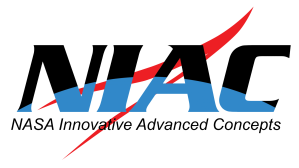
Host: Is your cadence typically annual? You get stuff once a year?
John Nelson: Yes.
Host: Okay. And is there any cap? You said you had 300 is about the median but is there—
Mike LaPointe: No. Again, it’s open. It takes a while to work through those. John puts on an orientation, not orientation, but a virtual proposals form every year after the solicitation, but before the proposals are due to, to explain to folks, you know, what it is we’re looking for. So it kind of helps kind of guide them a little bit in terms of what they’re going to be proposing and that helps focus the proposals a bit on the technologies we’re interested in, and keeps them from posing things like, you know, Star Trek warp drives, which are fascinating, but we can’t fund, you know, cause it’s a little too far down the road for us.
John Nelson: Or on the other end of the spectrum where it might be a very specific widget or an incremental improvement in a particular technology, which is perfectly suitable for some other programs. One of the reasons we have that virtual forum, and it’s usually about two weeks after we release facilitation, so it’s like middle of June, and it’s been very, very successful and popular, I think. The reason we have it is because even people who have proposed to other NASA programs, it’s a bit of an adjustment in proposing to NIAC cause we are different, you know, like I said, we’re not looking for incremental improvements. We’re looking for the unconventional. But at the same time, it’s got to be, founded in real science and real engineering. And as Mike said, we asked them to propose it in a representative mission in a mission context, so that it’s not just, “wow, look at warp drive” Well how would that be better than the ways we’re currently doing it? Or other options that are being pursued in early stage.
By putting it in the context of a mission, whether it’s real or not, sometimes people will just make up a mission, and that’s okay too. We’re not trying to find the ultimate application of your great idea. We’re trying to frame your great idea in a context that would allow people who know the discipline know aerospace, to be able to say, “yeah, this has significant benefits, this could be transformative.” That’s the purpose of the reference mission. And that’s a really hard concept for somebody proposing for the first time in NIAC to wrap their head around. So we do try to help folks as much as we can.
Host: Okay. Yeah. It’s an interesting gray, I could see why it’s an interesting gray area between a wild concept that’s based on nothing and like a very mature, very specific design. You’re in a very defined space there.
Mike LaPointe: To an extent. I mean, you’re still looking at the back of the envelope kind of. Or even, you know, written-on-the-napkin kind of concepts. But they do need to tell us why it’s a good thing for us to develop it.
Host: So you just came from the symposium so you might have some good examples to share. So for listeners who are trying to understand, what does a concept like that look like? If you think about maybe some phase one, some phase one ideas that you heard very recently over the past couple of days, what are some things that come to mind?
John Nelson: One I like to reference is FLUTE, it’s a Fluidic Telescope. So the idea is instead of having rigid optics in space mirrors, you would actually have a liquid that you could expand across a frame and essentially get to any size you want to and keep it liquid in space. So basically, picture like a giant liquid telescope that would be essentially impervious to micro-meteoroid attacks or other things. And with very high optical precision could get us to diameters that we couldn’t get to with conventional telescopes.
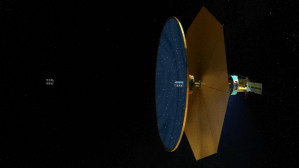
Host: Wow.
John Nelson: Yeah.
Mike LaPointe: That’s fascinating.
Host: That self-healing lens.
John Nelson: Yes. That one is being pursued by Edward Balabam out at Ames Research Center. Very promising.
Host: There was like a whole section when I was looking through the technologies and, you know different phases, but you had a whole series of them on propulsion, I thought. Really cool engine designs and propulsion. That probably excited you, Mike.
[Laughs]
Mike LaPointe: It does. Of course, we have no favorite children, but those are fun.
Host: That’s right. Any that come to mind? Just to share with our audience of something that you heard, during the symposium that is interesting, in a sense. I guess they’re all interesting. That’s not fair. I’m trying to characterize it in a way that is like not a favorite child, but something to share with our audience.
Mike LaPointe: Well being at JSC, human space travel. One of the concepts that we’re looking at is a wave rotor topper for a nuclear thermal propulsion engine. So NTP engines are being looked at for Mars transportation, for future human and cargo crews. It takes a long time to get to Mars, whether chemical or nuclear. And so what this is doing is increasing the specific impulse of a nuclear thermal rocket engine almost by a factor of two, up to about 1,300 seconds, give or take. And also in addition to that, they’re using the nuclear thermal propulsion reactor as a Brayton power cycle as well for nuclear high-power, nuclear electric propulsion. So it’s a bimodal system, which in itself is not new.
But what is new is the wave topper part of this thing where they can actually increase the Specific Impulse of the nuclear thermal part. So rather than having an 800 or 850-second nuclear thermal engine and a high specific impulse electro-propulsion engine, they actually have a high thrust, high ISP nuclear thermal engine as well. Three times better than a chemical engine can provide in terms of ISP. They can kick you out there a lot faster. So they’re looking at like 45 to 60-day transits to Mars, which is—
Host: What?
Mike LaPointe: Yeah, I know, this is awesome. We had a discussion, a keynote presentation from Dr. Suresh, the flight surgeon out here at JSC. And one of the things he said, you know, when asked about mitigation says, “go fast.” You know which is a great mitigation set. So this is a way we could actually go fast if it actually pans out and eliminate a lot of the biomedical problems that they face on long-duration journeys.
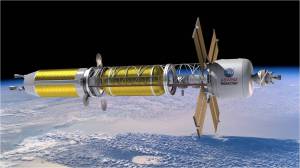
Host: Yeah. A lot. Biomedical, food systems, a whole gamut. Wow. Very, very interesting stuff. This is pretty wild. I’m looking at some examples that I pulled out. So one of them, cause human spaceflight, right? So I’m thinking Artemis, one was a pipeline for in situ oxygen on Mars. So this is like thinking way ahead, right? So, Artemis, if you think about the early concepts, this is really just sort of getting it going. But if you’re thinking about an infrastructure. You can have in situ resource utilization. Can you describe this one a little bit more?
John Nelson: Sure. So if you’re setting up a base and you have an ISRU production facility and you’re transporting the oxygen short distances, you can use rovers, robots. But what if we’re spreading large distances, in multiple directions, it becomes much more efficient mass-wise and in every other respect, to consider a pipeline. What’s really cool about this idea is they’re actually looking at the possibility of using ISRU materials, metals from lunar regolith to actually create the pipeline itself and then transport the oxygen from the ISRU production to habitats and other facilities that need it.
Host: Yeah. And ISRU created ISRU capability.
Mike LaPointe: Exactly.
Host: That’s very cool. This one really caught my attention because it’s thinking so far out into the future of like, okay, what is Artemis capable of? Let’s see how we can support it.
Mike LaPointe: It’s kind of like John mentioned, you know, for short distances, using a rover with a doer on the back is great. It’s kind of like our tankers on the roads today. But if you want to really pipe something, you know, a long distance, you know, pipes are much more efficient than trucking it across the interstates.
John Nelson: And that one’s being pursued by a company here in Houston called Lunar Resources.
Host: Very cool. Alright. Another reason to call it out. You can see the ones I picked. So I mean high-level NIAC, right? So if someone asks you about NIAC and, you know, why is it so important to pursue technologies in the early stages? Why not stick with the more mature stuff, the stuff that you know has a mission tie. When someone asks you why is it so important to work with these companies, with these individuals, with these scientists who have these very interesting, crazy thoughts and give them a platform to help to mature it. How do you address that?
Mike LaPointe: Well, pretty much all the technologies we have today started out as a crazy idea way back when, right? All the way from people scrubbing clothes on the washboard to the washing machines we have today. You know, someone had to take that initial vision, say, “you know, we could probably do this automated somehow.” You know, and eventually move it along that way. So I think, you know, as John likes to say, NIAC is the dream shop for NASA, right? We’re the ones that are looking 30, 40, 50 years down the road and saying, “what if, you know, we could do this and give us this capability? How do we actually get there from where we are today?” And that’s why I think NIAC is so important. You know, it’s the seed corn for the really far-term future capabilities that NASA, and frankly, that I think that the public expects NASA to be doing.
Host: So how does NIAC measure success then? Cause I’m sure there are some that get matured and some that maybe fall out, some that, you know are hopeful. So how do you measure success?
John Nelson: So I think we have to look at success from different perspectives. So within STMD or any technology development program, transition and infusion and emissions is a very important metric. It always is, right? And it’s important to us, but it’s not the only measure. So we do track it and we fall in that 20 to 30% range in terms of NIAC ideas that move on to additional funding beyond NIAC, which I think is pretty good. I think anything higher than that would have to question whether or not we’re actually cutting edge, you know? We don’t consider outcomes of NIAC to be failures unless we don’t learn anything. Knowledge transition is just as important as the transition of technology itself. So we do track transition and wherever possible, we try to help encourage that and introduce potential stakeholders to fellows.
We haven’t talked yet about the phases. But phase two, which is long, a little longer in duration and higher in value, $600,000 for two years. We have a midterm review halfway through. So we’ll try to bring in reviewers for that midterm review that is maybe from other government agencies or other offices in NASA that might be able to look at this technology in the next steps. We try to do what we can, recognizing that even for the most promising technologies, it’s a very hard feat. But even beyond transition and infusion, we look at something else that we think is even more important. And that’s inspiration. So NIAC has been around in a couple of iterations for a couple decades now. We’ve got some really good examples where some of our best successes weren’t things that necessarily were continued from one step to the other by the same lab. They served as inspiration.
So the Ingenuity helicopter on Mars. That was not a NIAC project. However, there was someone at JPL who went to a talk by somebody who had a NIAC back in the early two thousands for, not the same, but a similar idea of a helicopter on Mars. They were inspired to pursue it, and it was one of the things that inspired Ingenuity, which is obviously on the surface of Mars now. Similarly, two or three years ago, we had the MarCo mission, which was the first time we used deep space Cubesats, went to Mars. And in 2012, we funded Rob Staehle to look at using deep space Cubesats. At the time, they were relatively new and everyone was thinking of it as low-Earth orbit, you know, and NIAC invested in a study that said, “what if? what if we could actually use these for deep space?” Well, it’s happened, it happened three years ago. Again, it wasn’t Rob Staehle who developed it, it wasn’t a clean path where we can say “NIAC transitioned from this program to that program.” But we know it inspired it. And we see that as success. So for us, inspiration matters, and that would be my answer.
Host: Which is funny, because that’s one of the agency goals: inspiration. When you talk about NASA and what NASA’s trying to do, it is inspire, so it’s right in line with agency goals. I do want to make sure we spend some time talking about the phases. So you mentioned phase two. Mike, if you can expand a little bit more on just how it works. When it comes to maturity, how it works from phase one to three.
Mike LaPointe: So phase one is the entry point. As I mentioned, we have a two-step phase one process where step A’s are very short white paper submissions that we then look through and invite for step B, which is the full proposal for phase one. And once awarded, phase one’s are nine-month activities for $175,000, typically grants. NASA centers can apply as well, which is just transfer at that point. Successful phase ones can then apply for phase two. Phase two’s are for two years and $600,000. And that puts more meat on the bones of the concept. You know, I think phase one, like Ron likes to say, is to tell us why we should develop your special sauce. And phase two is to start developing that sauce.
And so we expect at that point, by the end of phase two, to have a better idea of the feasibility, and potential transition opportunities as well. Whether there’re spinoffs or if they’re actually, you know, this could transition into a mission down the road. Following phase two is a phase three activity, which is very rare. Now we fund one per year at most. This year we actually did not fund any, but phase three is for $2 million in two years to really flesh out the concept and really look for those transition opportunities to take that technology to the next step and move it along.
Host: To start making the sauce and doing a couple taste tests before you actually roll it out to market.
Mike LaPointe: See if someone’s interested in buying that—
Host: Buying that sauce. The sauce analogy really is good.
[Laughs]
Mike LaPointe: Thank you. That’s Ron’s.
[Laughs]
John Nelson: We stole that from Ron.
Host: Alright. Something to leave our audience with, guys, is just the importance of continuing this, right? So just to leave us with the idea that we have this sense of inspiration. We have a good understanding of what NIAC is, what it does, but something to really excite our audience, and really just understanding, just crazy concepts—why we do it. I think John, you answered beautifully with the example of inspiration. Mike, I guess we’ll pass this one to you to just sort of wrap us up—
Mike LaPointe: I have to follow that, really? Thanks a lot.
[Laughs]
Host: John did good. John did real good.
Mike LaPointe: He did. Why we hired him, man.
[Laughs]
Mike LaPointe: So I think a NIAC in general, I mean, I think the things we’re doing is actually what people expect NASA to be doing, right? I mean, landing people on the Moon is awesome, you know? And that’s just an incredible feat to do that. But people are looking at why aren’t we out at the outer planets with people? You know, why aren’t we doing interstellar missions? There’s a lot of activities. I think people look at NASA as their inspiration, right? This is the place where people go to be inspired. Not just in terms of technology, but in human capability. You know, what is it that people can actually do? And this is what NIAC is for, you know, we provide that like John says, a dream shop for people to actually envision what that future could look like. And then we try to help make that happen.
Host: See, you did just fine.
Mike LaPointe: Nah, nah. I was just secondary compared to John.
Host: No, it was such a pleasure to have both of you on it. I know this is coming like right at the back end of the symposium but I’m glad I got to coast off of your energy these past couple of days and get to pick your brains a little bit. So I appreciate both of you coming on. Mike. John, thanks for coming on Houston We Have a Podcast.
Mike LaPointe: Thank you for inviting us.
John Nelson: Thank you so much.
[Music]
Host: Hey, thanks for sticking around, awesome conversation with Mike and John today. Hope you learned something. Check out NASA.gov for the latest on NIAC, some of the cool inventions they have. A lot of the things that we discussed today can be looked into further on NASA.gov so make sure you check out that if you want to learn more and some of the many other things, many, many other things that we didn’t discuss today. Of course, we’re not the only NASA podcast. You can check them all out at NASA.gov/podcasts. And if you want to talk to us, we’re on Facebook, X, Instagram, you can use #AskNASA on the NASA Johnson Space Center accounts of any one of these and submit an idea. Make sure to mention it’s for us at Houston We Have a Podcast, though, so we can know it’s for us. This episode was recorded on September 21, 2023. Thanks to Will Flato, Dame Turner, Abby Graf, Jaden Jennings, and Kathy Reilley. And of course, thanks again to Mike LaPointe and John Nelson for taking the time to come on the show. Give us a rating and feedback on whatever platform you’re listening to us on, and tell us what you think of our podcast. We’ll be back next week.
























